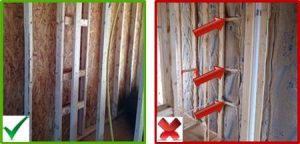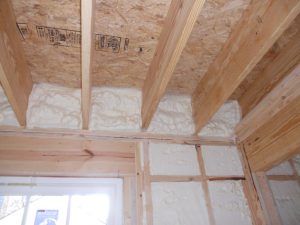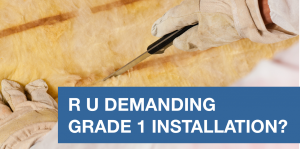Current Practice in New Homes
Almost all of the homes observed in our recent Field Study of New Home Energy Efficiency Practices met the requirements for the amount of insulation installed in the 2009 Energy Code. Thirty-nine percent of wall insulation installations and 27% of ceiling insulation installations did not meet Resnet Grade I for installation quality
2015 IECC Insulation Requirements:
| Climate Zone | Wall R-Value | Ceiling R-value |
Floor R-value |
| 2 | 13 | 38 | 13 |
| 3 | 20 or 13+5* | 38 | 19 |
| 4 | 20 or 13+5* | 49 | 19 |
* 13+5 = R 13 wall cavity + R5 continuous insulation
Energy Code Requirements:
The 2015 IECC has different requirements for wall and ceiling insulation R-values for each climate zone in Texas. The code in Table R402.4.1.1 also specifies criteria for insulation installation quality that are roughly equivalent to a Resnet Grade I installation.
Bringing all new homes in Texas into compliance with the 2015 Energy Code requirements for wall and ceiling insulation will save Texas homeowners $3,027,369 each year.
Guidelines for Insulation R-values and Installation
Define the Thermal Barrier:
R103.2.1 of 2015 IECC (IRC 1103.2.1) requires that the Thermal Barrier be depicted on the construction documents and R103.2 requires that insulation materials and their R-values be shown on the construction documents. This is important because it is not always clear where the insulation should be placed. Ceiling height changes, conditioned spaces in attics and combustion appliance rooms are areas that are often not insulated correctly.
Perform a Pre-Insulation Inspection:
Before insulation can be installed properly the contractor or installer must make sure the building is ready for insulation. The inspection should include making sure corners and tees are framed to allow all areas of the exterior wall to be insulated. Blocking and sealing must be in place to make sure there is no air intrusion into the insulation. This is the time to make sure the air barrier is in place on knee walls and attic hot walls, on soffits and fur downs and behind tubs, showers and fireplaces on exterior walls. All air sealing must also be in place before the insulation is installed.

Photo: Appalachian State University
Install the Insulation Properly:
There are five major flaws that must be avoided when installing any insulation.
Compression. Air permeable insulation must not be compressed. Compression reduces the effectiveness of the insulation. To avoid compression batts must be cut to size in narrow cavities. They must be split to fit around wires and pipes and must be cut to fit around and behind electrical boxes.
Gaps. Gaps are spaces between the insulation and framing members or between pieces of insulation that are butted together. Gaps allow a direct thermal transfer between the outside and the inside, reducing the effectiveness of the insulation.
Voids. Voids are areas with no insulation. This might be behind electrical boxes or where the insulation has been moved aside to allow work to be done and not replaced. Voids also allow a direct thermal transfer between the outside and inside.
Misalignment. Misalignment is where the insulation is simply in the wrong place, not in contact with the floor sheathing for floor insulation or where ends of batts do not align. Misalignment can effect insulation effectiveness in many ways, none positive.
Air Intrusion. Air intrusion usually occurs where blocking is missing or not sealed and allows air to flow into and through the insulation. A good example is when the space between ceiling joists is not blocked and sealed at the transition between the garage and conditioned space. Air intrusion brings unconditioned air into the insulation, reducing its effectiveness.

Photo: Appalachian State University
Perform Insulation Inspection Before Installing Drywall. It is crucial to perform a thorough insulation inspection before beginning to install drywall or other finishes. Inspect for the five major flaws to make sure the insulation was installed properly and has not been moved since the installation.
Resources:
NAIMA, the North American Insulation Manufacturers’ Association, has developed a series of videos on installing air permeable insulation. These videos can be viewed here.
NAIMA also has written guidelines for insulation that can be found here.
SPFA, the Spray Polyurethane Foam Alliance, has technical information on their website.
